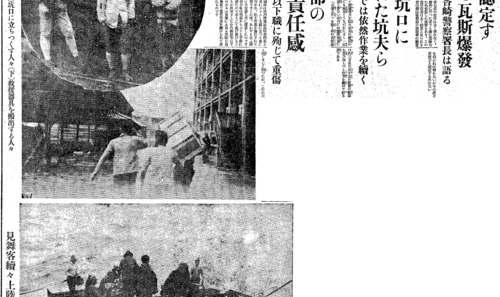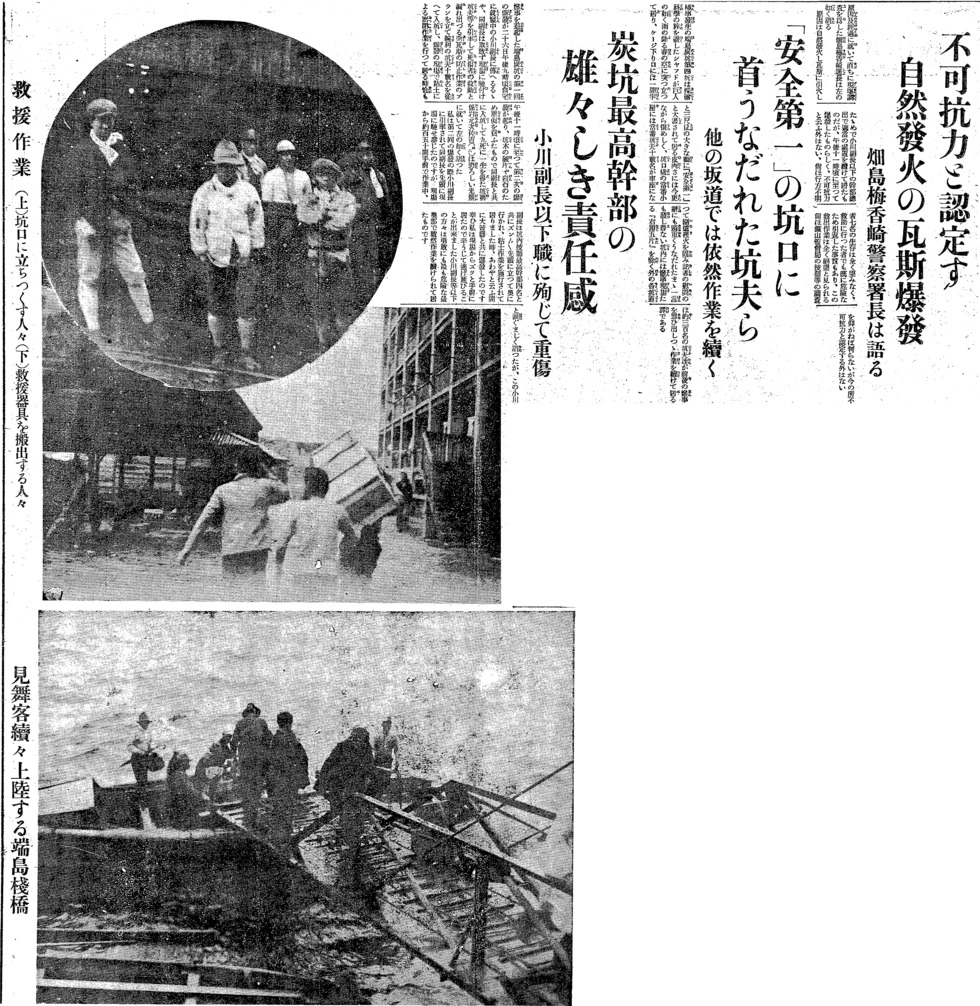Spontaneous Gas Explosion – Determined to be Act of God
“Spontaneous Gas Explosion – Determined to be Act of God”
March 27, 1935 (Showa 10) Nagasaki Nichi-nichi Shimbun
Largest Gas Explosion in Hashima Coalmine History
The largest gas explosion in Hashima Coalmine history:
Nagasaki Nichi-nichi Shimbun issued an extra edition to report the details of the accident. The company’s top officer who was directing the rescue effort died in a secondary explosion. According to reports, the number of dead had reached 27 as of the printing of the evening edition on the 30th. Of the dead, 18 were Japanese and nine were Korean. There is no evidence that dangerous work in the Hashima Coalmine was assigned exclusively to Korean miners. At the time of the accident, the island of Hashima had a total population of 3,200 people. Of the 1,000 employees of the mine, 700 were miners. (Nagasaki Nichi-nichi Shimbun)
Nagasaki Nichi-nichi Shimbun (March 27, 1935 [Showa 10] Extra Edition)
Detailed report on major gas explosion at the Hashima Coalmine outside Nagasaki Bay.
Death at 2,000 shaku below the surface – What is the fate of the remaining seven?
Three critically injured die while being treated at mine hospital.
Miners bow their heads in front of “Safety First” sign at mine entrance.
Top executives’ valiant commitment to duty – Deputy Manager Ogawa and others seriously injured in line of duty.
Authorship: Materials provided by National Diet Library
Nagasaki Nichi-nichi Shimbun: Newspaper
(Photo) Rescue operation
(Top) People stand in shock at mine entrance
(Photo)
(Bottom) Carrying rescue equipment to the mine
(Photo) Anxious visitors landing at Hashima wharf
- Author
Page 1
Accident Determined to be Act of God
Spontaneously Ignited Gas Explosion
Chief Hatakejima of Umegasaki Police Department Speaks
Chief Hatakejima of Umegasaki Police Department spoke after immediately investigating the cause of the accident and related developments.
“The cause was a spontaneous ignition that triggered a gas explosion. Deputy Manager Ogawa and all mine officers rushed to the scene and took appropriate actions. It appears the explosion occurred at around 11:00 a.m. and there is no other way to describe it but as an act of God. There is no hope for the survival of the seven missing persons, and those who joined the rescue have been forced to retreat because of the dangerous situation. I believe rescue efforts to be totally hopeless.
“A final determination will have to await the findings of the engineers of the Hiroyama Board of Supervisors, but for now, there is no option but to say that the accident was an act of God.”
Miners Bow their Heads in Front of “Safety First” Sign at Mine Entrance
Operations Continue at Other Tunnels
The No. 4 Hashima Tunnel, where the accident occurred, stands at the cutting edge of science with its giant shaft rising tall into the rain-filled spring skies. “Safety First” reads the large sign–270 cm across and 90 cm wide–that hangs at the entrance of the cage that descends deep into the earth. The irony is too much to bear. A dozen miners sit in a circle around an open hearth in the staging shed near the mine entrance. Their heads bowed low, they have no words for the reporter that is trying to console them. With the exception of the “No. 5 downward sloping shaft” where the accident occurred, some 300 miners continue to do their work in all other shafts. Their thoughts, however, are turned to the previous night’s tragedy.
Top executives’ valiant commitment to duty
Deputy Manager Ogawa and others seriously injured in line of duty
Deputy Manager Ogawa was asleep at home when news of the first explosion was brought to him at around 9:00 p.m. on the 26th. He rushed immediately to the scene with a number of miners in tow and immediately began planning for the rescue operation and stopping the outflow of explosive gas. He then entered the mine with a dozen of his best men. The second explosion occurred at around 11:00 p.m. just as the crew was using clay to seal off the site of the explosion. Deputy Manager Ogawa was seriously injured by flying rocks and shards of wood from the tunnel framing. A mine employee, Jisakichi Iwamoto (age 42) who went into the mine with Deputy Manager Ogawa and narrowly escaped death, tearfully described the harrowing scene of the explosion.
“I went into the mine with Deputy Manager Ogawa before the second explosion and he led the way as we approached the site of the accident. About a 150 ken [270 meters] from the site, I stopped to work on something, but the Deputy Manager and four others (mine engineers and top officers of the mine) kept on going deeper into the mine. They were working to seal the tunnel with clay when suddenly there was a huge explosion. Fortunately, I was working at quite a distance from the blast and escaped injury. Deputy Manager Ogawa and the others were bravely working in the most dangerous parts of the mine.”
The valiant actions of Deputy Manager Ogawa and the four mine officers and their utter commitment to duty has become a source of inspiration for the entire mine.
(March 27, Showa 10 [1935]



